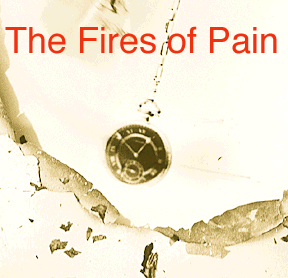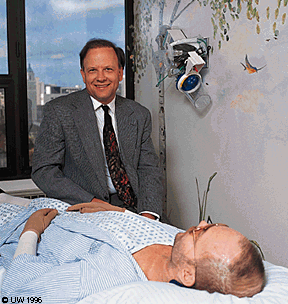

It was freak injury, the young man explains. While working at a local microbrewery, excess pressure in a brewing vessel blew 240-degree water across his back and legs. As soon as they saw the severity of the burns, emergency medical techs rushed him to Harborview Medical Center, site of the University of Washington Burn Center.
Five days later, he is resting in his hospital bed, greeting his visitors pleasantly. His bedclothes conceal the severe burns that run from his shoulder blades to the backs of his calves.
Burns are the most painful injuries people can have, says UW Burn Center Director David Heimbach, and the young man knows that all too well. He spent his critical first few days in the burn intensive care unit (ICU), but it is now, as he recovers in the burn/plastics unit, that pain has started consuming his body.
"I don't know how much pain I had when I was in the ICU, because I was fully sedated," the man recalls. "The hardest time came when I came to this unit and had to have my dressings changed. I was taking 26 mg of Dilaudid [a high dose of a strong opiate] for the intense short-term pain I was feeling then."
To help relieve the agony, psychologist David Patterson, UW associate professor of rehabilitation medicine, is speaking with him the day before plastic surgeons plan to graft skin to the backs of both legs.

This isn't the first time Patterson has seen the patient. When the brewery worker came on the ward, Patterson offered him another way to reduce the pain--hypnosis. Patterson carefully explained that hypnosis is not a cure but an adjunct to the pain medication the man was already taking.
Now, Patterson says, the patient is on the Pain Relief Service's "Cadillac plan." Because of his extensive burns, nurses must change his dressings frequently to prevent infection and aid in healing. So the patient takes Dilaudid as well as a topical anesthetic at the site of his wounds. And, 30 minutes before each dressing change, he is hypnotized to trigger a relaxation that keeps him from thinking about the pain.
"I was having a hard time during the 15 minutes it took to remove my dressings each day," the brewery worker says. "The hypnosis calmed me--I went from a pain level of eight or nine to four or five."
Patterson's voice is soft and soothing as he hypnotizes the patient, and there are pauses between each number as he counts to 10. Phones ring and staff enter the patient's room during the session, but the patient seems not to notice.
As he counts, Patterson encourages the patient to relax deeply, feel comfortable and slow his breathing. Even though part of him can hear the phone, Patterson suggests, another part only hears the psychologist's voice.
"When you go into surgery tomorrow, you'll have no feelings other than comfort and relaxation," Patterson says. "The surgery is exactly what you need to make you feel better and go home sooner. You're going to be surprised at how easily the whole procedure goes for you. You may not remember this, but maybe sometime in the future you'll be astounded at how comfortably the surgery went and how rested and relaxed you were during the dressing changes."
Pain is What They Remember Best--and the
Longest
Using Hypnosis to Control Pain
Drug Addiction? It's Not a Threat to Burn Patients
Mind over Matter--Virtual Reality and Pain Control
Send a letter to the editor at columns@u.washington.edu.